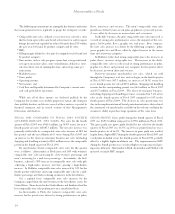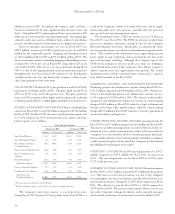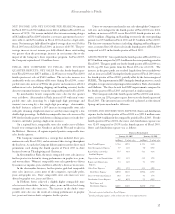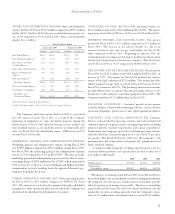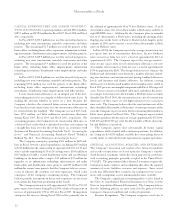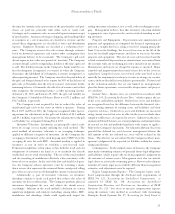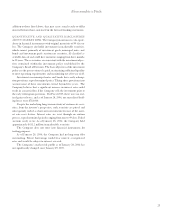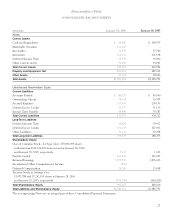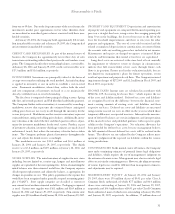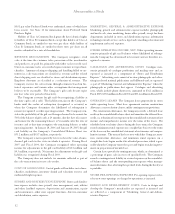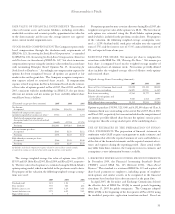Abercrombie & Fitch 2005 Annual Report Download - page 25
Download and view the complete annual report
Please find page 25 of the 2005 Abercrombie & Fitch annual report below. You can navigate through the pages in the report by either clicking on the pages listed below, or by using the keyword search tool below to find specific information within the annual report.
ending inventory valuation at cost as well as the resulting gross mar-
gins. Management believes that this inventory valuation method
is appropriate since it preserves the cost-to-retail relationship in end-
ing inventory.
Property and Equipment - Depreciation and amortization of
property and equipment are computed for financial reporting pur-
poses on a straight-line basis, using service lives ranging principally
from 30 years for buildings, the lesser of ten years or the life of the
lease for leasehold improvements and three to ten years for other
property and equipment. The cost of assets sold or retired and the
related accumulated depreciation or amortizations are removed from
the accounts with any resulting gain or loss included in net income.
Maintenance and repairs are charged to expense as incurred. Major
remodels and improvements that extend service lives of the assets are
capitalized. Long-lived assets are reviewed at the store level at least
annually for impairment or whenever events or changes in circum-
stances indicate that full recoverability is questionable. Factors used
in the evaluation include, but are not limited to, management's
plans for future operations, recent results of operations and project-
ed cash flows.
Income Taxes - Income taxes are calculated in accordance with
SFAS No. 109, “Accounting for Income Taxes,” which requires the use
of the asset and liability method. Deferred tax assets and liabilities
are recognized based on the difference between the financial state-
ment carrying amounts of existing assets and liabilities and their
respective tax bases. Deferred tax assets and liabilities are measured
using current enacted tax rates in effect in the years in which those
temporary differences are expected to reverse. Inherent in the meas-
urement of deferred balances are certain judgments and interpretations
of enacted tax law and published guidance with respect to applica-
bility to the Company’s operations. No valuation allowance has been
provided for deferred tax assets because management believes the
full amount of the net deferred tax assets will be realized in the
future. The effective tax rate utilized by the Company reflects man-
agement’s judgment of the expected tax liabilities within the various
taxing jurisdictions.
Contingencies - In the normal course of business, the Company
must make continuing estimates of potential future legal obligations
and liabilities, which requires the use of management’s judgment on
the outcome of various issues. Management may also use outside
legal advice to assist in the estimating process. However, the ultimate
outcome of various legal issues could be different than management
estimates, and adjustments may be required.
Equity Compensation Expense - The Company reports stock-
based compensation through the disclosure-only requirements of
SFAS No. 123, “Accounting for Stock-Based Compensation,” as
amended by SFAS No. 148, “Accounting for Stock-Based
Compensation–Transition and Disclosure–an Amendment of FASB
Statement No. 123,” but elects to measure compensation expense
using the intrinsic value method in accordance with Accounting
Principles Board Opinion No. 25, “Accounting for Stock Issued to
the time the customer takes possession of the merchandise and pur-
chases are paid for, primarily with either cash or credit card.
Catalogue and e-commerce sales are recorded upon customer receipt
of merchandise. Amounts relating to shipping and handling billed
to customers in a sale transaction are classified as revenue and the
related direct shipping costs are classified as stores and distribution
expense. Employee discounts are classified as a reduction of rev-
enue. The Company reserves for sales returns through estimates
based on historical experience and various other assumptions that
management believes to be reasonable. The Company’s gift cards
do not expire or lose value over periods of inactivity. The Company
accounts for gift cards by recognizing a liability at the time a gift card
is sold. The liability remains on the Company’s books until the ear-
lier of redemption (recognized as revenue) or when the Company
determines the likelihood of redemption is remote (recognized as
other operating income). The Company considers the probability of
the gift card being redeemed to be remote for 50% of the balance of
gift cards at 24 months after the date of issuance and remote for the
remaining balance at 36 months after the date of issuance and at that
time recognizes the remaining balance as other operating income.
At January 28, 2006 and January 29, 2005, the gift card liability on
the Company’s Consolidated Balance Sheet was $53.2 million and
$41.7 million, respectively.
The Company is not required by law to escheat the value of
unredeemed gift cards to the states in which it operates. During
Fiscal 2005 and Fiscal 2004, the Company recognized other operat-
ing income for adjustments to the gift card liability of $2.4 million
and $4.3 million, respectively. No income for adjustments to the gift
card liability was recognized during Fiscal 2003.
Inventory Valuation - Inventories are principally valued at the
lower of average cost or market utilizing the retail method. The
retail method of inventory valuation is an averaging technique
applied to different categories of inventory. At the Company, the
averaging is determined at the stock keeping unit (“SKU”) level by
averaging all costs for each SKU. An initial markup is applied to
inventory at cost in order to establish a cost-to-retail ratio.
Permanent markdowns, when taken, reduce both the retail and cost
components of inventory on hand so as to maintain the already
established cost-to-retail relationship. The use of the retail method
and the recording of markdowns effectively values inventory at the
lower of cost or market. At the end of the first and third fiscal quar-
ters, the Company reduces inventory value by recording a mark-
down reserve that represents the estimated future anticipated selling
price decreases necessary to sell-through the current season inventory.
Additionally, as part of inventory valuation, an inventory
shrinkage estimate is made each period that reduces the value of
inventory for lost or stolen items. The Company performs physical
inventories throughout the year and adjusts the shrink reserve
accordingly. Inherent in the retail method calculation are certain
significant judgments and estimates including, among others, IMU,
markdowns and shrinkage, which could significantly impact the
Abercrombie &Fitch
23



